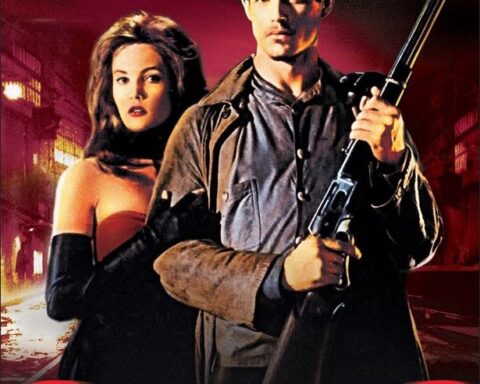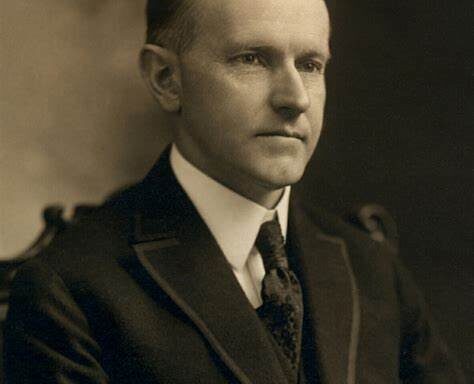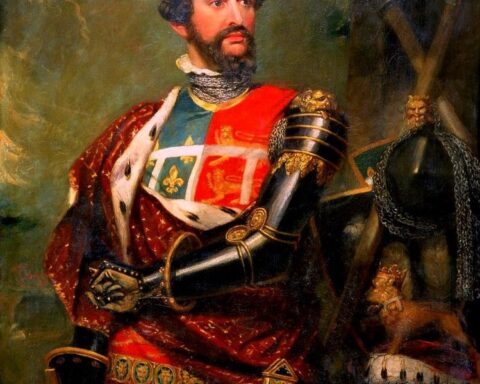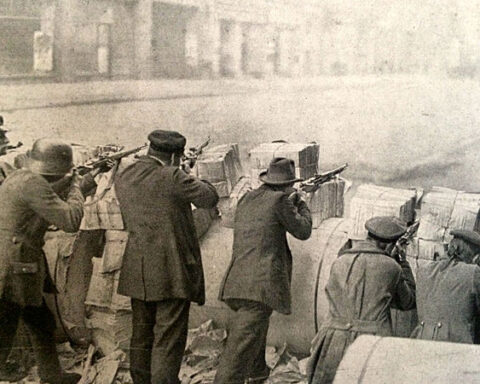Editor’s note: The following comprises Chapter 1 of Children of Yesterday, by Jan Valtin (published 1946).
My commanding officer in the jungles was Lloyd Price of the Dallas News. My section sergeant was Verne Mabry of the St. Louis Globe-Democrat. As I climbed from a jeep to report for duty, I found Captain Price squatting in the dust of Mindoro Island beneath a piece of sheet iron. He was desperately engaged in driving a rusty nail through the iron, using the handle of his bush knife as a hammer. His assistant, Sergeant Mabry, introduced me to our superior with a melancholy grin. Dangling above us from a scarred tent pole was a Japanese helmet full of bullet holes, spattered with dried blood, and bearing the inscription, PRO.
“Private First Class Richard Krebs,”[1] I said, “reporting for duty with the 24th Infantry Division.”
Price shook the sweat from his face, cursed the rusty nail, looked me over with a smile and said, “Welcome, don’t you think you are too old for the infantry?”
“Never mind,” said Mabry, his leathery face in crinkles, “we are old bastards too.”
“Can I help you?” I asked politely.
“Do you know what we are doing?” demanded the captain.
“No.”
“We are building a table,” he said.
Mabry laughed. “The fellow who was here before you went home,” he explained. “He had a fighting cock named Typhoon. Typhoon was raised on vitamin pills— He won every fight. But the fellow who owned him went home, and that’s why you are here. Have you ever worked in a newspaper office?”
“No,” I said.
“This is going to be our office,” announced Captain Price.
“It’s a nice place,” Mabry said. “Back on Leyte we had our office dug under a pigsty. After that we had another office in a native jail. Let’s give the captain a hand to straighten out that rusty nail.”
This was my introduction to two of the finest men I have had the good fortune to call my comrades in tropical warfare. Without their steadfast co-operation through torrential night rains, blazing days, mud, invasion and gunfire the pages that follow would have never been written. The office we built that day on Mindoro consisted of a battered canvas roof, three sheets of iron fastened to bamboo sticks to serve as desks, three ration boxes for chairs, three decrepit typewriters with repair tools designed for six-wheel trucks, firearms, ammunition, a drainage ditch, a miniature generator, three tonettes, a bottle of atabrine pills and a filing cabinet marked, ‘To Accompany Troops.” On one side mountains hulked purple and forbidding under an angry sun; on the other, some distance away, lay the invasion beach littered with hastily dumped supplies. There was a roar of motors in the sky and there were truck columns laden with troops rumbling inland over dusty roads. A hot wind blew volcanic sand into weapons and typewriters, and into men’s ears and eyes.
I had arrived from rain-soaked Leyte that morning, after a turn along the shores of New Guinea, Biak and Windy Island. I had walked off the LCI, waded up the beach under duffel bag and Garand, pestered by bottle flies and wondering what my new assignment would be. In a field of cogon grass a sweating lieutenant had called out my name, had leered at me, and had said: “Report for duty with P-R-O.”
“PRO,” I had wondered, “what could that be?”
I had then asked a sergeant loafing under a lauan tree about the meaning of those three letters. He spat between the thick roots and said: “PRO, PRO— well, that’s the 24th Division PRO-Station.”
“What?”
“Prophylactic station, you dope.”
I said nothing.
“It’s a good deal, Mac,” the sergeant had continued. “You won’t be out killing Nips an’ sleeping in holes full of water. You’ll set up shop near the whorehouses, and all you’ll do is see that the guys do a right good job of sanitation after they’ve had their fun.”
Captain Price guffawed when I told him of my silent horror. “PRO,” he said, “stands for Press Relations Office, not pro-station.”
“We’d better get some paint and change our shingle,” Mabry grinned. “Change PRO to P.R.O.”
“Our job,” the captain said to me, “is to do the combat reporting for the Division.”
“We are the nursemaids of the correspondents,” Mabry cut in with a sardonic grin. “We are the paragraph troopers in nowhere. Some day you’ll go out to get a good story from some Joe, and then you’ll find the guy with his head blown off.”
We labored until darkness, and ate a meal of canned frankfurters and dehydrated potatoes, and then we went to a swift-flowing stream to wash off the day’s grime. Truck drivers bathing from their vehicles in mid-river told of patrol clashes in the nearby hills. One of them had spotted a cave inhabited by Japanese soldiers. At the cave entrance three Japs sat on a case of dynamite, eating rice. The truck driver had placed a bullet accurately into the case. The explosive blew up, killing the Japs, bringing down the cave mouth and leaving the survivors sealed in the tomb. Sergeant Mabry got the story, and after that we fled from the mosquitoes. During the night a carabao, huge and black, disturbed our sleep, drinking water from our helmets. Mabry shooed him away with an unearthly roar. Toward morning an airplane crashed nearby and burst into flame. We ate dehydrated eggs at dawn and found Captain Price in battle dress, off to accompany a rifle battalion in the storming of Fortress Corregidor.
The Twenty-Fourth is typical of the few infantry divisions which specialized as assault spearheads in tropical terrain. In ten months of sustained fighting and incessant island raids its members have killed 25,000 Japanese warriors in the Philippines. To the participants, these ten months are like ten centuries. Packed between October 20, 1944, which was the day of the Leyte invasion, and the order to “cease firing,” lay a reality which in retrospect assumes the fiber of an enormous and fantastic dream. We turn in our rifles and grenades to the supply sergeant, and we board the troopship homeward bound, looking toward home, and already the commonplace of yesterday seems to become unreal and remote in our war-sick minds. With disbelief we gaze at the immediate past, and it is as if each of us asks himself, “Was I ever a part of that?” And we brush away the memory of a tawny woman screaming in a burning hut, or of an enemy’s smile in the face of violent finality, or of the stench of a friend’s corpse beneath the midday sun, the flies and the whining shells.
But this is not a personal history. It is the story of the men of the Twenty-Fourth Division and of the battles they fought and won without ever being sure about the necessity for their agonized giving. But give they did with choiceless and bitter extravagance. They gave with envy in their hearts for the folks at home, often worrying if a miserable allowance would buy their mothers or their children enough to eat, often angered by reports of civilian fleshpots brimming over the bleak fires of war, often hurt by wives unwilling to bear the hardships of fidelity. In their personal deeds the men took no more pride than they would in any detested job well done. They hate war more than they ever hated their enemy, but they are proud of their Division. Those who have had dealings with this Division know it as the Victory Division. It has fought many battles and lost none. Its non-secret code letter, stencilled on its trucks and guns, is “V.”
My job as Division reporter, on the prowl for stories, took me at various times and places to all of the Division’s units.[2] A combat reporter’s crop of notes gathered during a random day’s jeeping, hiking, creeping, and squatting in the Mindanao campaign yielded the following— typical— collection:
Corporal Lawrence Taylor of Wasaugal, Washington, drove a truck five miles behind American lines near Davao. After he had reached his destination, an officer remarked that the truck was riddled.
“Can’t be,” said Taylor. “It’s new.”
But there were nineteen bullet holes in the truck. The corporal then remembered that he had heard a machine gun cracking off the road but that he had paid no attention to the noise.
Colonel “Jock” Clifford, commander of the Nineteenth Infantry Regiment, offered a prize for any Japanese soldier killed by a native Mohammedan Moro. Some days later a squat Moro walked into Clifford’s tent and plumped a Jap head on the Colonel’s desk, demanding the prize money. Clifford, one of the finest soldiers in the Division, jumped up, roaring, “Take that damn thing off my table.” An orderly seized the head and tossed it onto a nearby crossroads. The head lay there for days, kicked hither and yon by passing men and trucks, until a vulture carried it away.
Private First Class Eugene Monroe of Eugene, Oregon, and other men of his rifle platoon lay resting along a jungle trail. There was a crackling in the house-high grass. Seven Japanese soldiers mounted on water buffaloes came riding up the trail. Not one survived the fusillade. No buffalo was killed. The carabaos trudged on into a swamp and wallowed in the mud.
A sign posted at the entrance of a Filipino school which had been looted of all its furniture by American soldiers camping nearby read: “Americans stand for decency and always must. If you trample on decency, you trample to death the thing that makes you Americans. Sincerely yours, Maria Padata.” The soldiers read the sign and were ashamed. They carried half of the furniture back under cover of darkness. The other half they already had used for firewood.
A patrol surrounded two Japanese in a pillbox near Bayabas. A Nisei stepped forward and yelled, “Jap soldiers— surrender!”
The Japs replied: “Come nearer so we can kill you.”… The Nisei laughed. “It is you who face death!” he said, “unless you surrender we shall burn you.” The voice in the pillbox replied calmly, “Then burn me, Americans.” A rifleman tossed a phosphorus grenade. The Japanese dashed into the open and were cut down. They looked like red-headed Japs, but it was only their hair burning brightly.
On the upper Talomo River a scouting patrol found a dead enemy soldier. He had been wounded by our artillery. Then someone had stabbed him to death and stripped his rumps of flesh. Later that day, on the Kibawe Trail, the scouts found the nude bodies of fifty Japanese. The backs and legs of many had been stripped of flesh. The Japs were eating their own to retain the strength to fight.
Private Byron Becker of Aberdeen, South Dakota, heard the sounds of snoring float from a bamboo hut. He found a sleeping Japanese and a club. He picked up the club and poked the Jap and said, “Hey there, wake up.” But the yellow man jumped up, seized the club and aimed blows at Becker’s head. The American lunged sideways, aimed his submachine gun and killed the Japanese. On that day another soldier, from Kentucky, found a sick and starving Japanese lying at the edge of a jungle trail. But the Kentuckyman, who had killed seventeen Japs in eighteen months, was tired of killing. He loaded the sick Jap on his shoulders and trudged toward bivouac. He arrived at the aid station two hours later and found that his prisoner had died on the way. He decided then that never again would he try to take a Japanese alive. Two days later, on a path leading through an abaca plantation, he came face to face with a ragged Japanese who hugged a package which had the size of a mine. The Jap yelled, “No shoot, I surrender.” The Kentuckyman cursed and fired. The Japanese dropped dead. Searching the corpse, the American found that the other had been carrying a sleeping baby. The child, still peacefully asleep, had remained unhurt.
A little way off, Corporal William Miller of Philadelphia walked through a half-burned and abandoned village. He found a house full of pianos made in Japan. Miller liked pianos. He set aside his rifle, searched out a piano that was well tuned and beat out a few melodies. He had not played a piano since he had left home years earlier. The notes of “Beat Me, Daddy, Eight to the Bar,” and “Shoot the Sherbet to Me, Herbert,” had barely come to an end when a rifle shot rang out, followed by others. The corporal grasped his weapon and dived behind the piano and waited. He saw a disgusted-looking American private gaze through a window.
“Did you shoot?” yelled Miller.
The private nodded. “I should’na disturbed you,” he drawled, “but two Nips out here were gonna throw some grenades at you through the winder.”
“Are they gone?” asked Miller.
“Naw,” the private said, “I shot them.”
Much of the Philippines war was fought in countless obscure actions most of which have never been reported in the western world. Everyone has read the dispatches on the conquest of Manila or the Battle of the Ormoc Valley on Leyte; but how many people have ever heard of Breakneck Ridge where hundreds of Americans died in typhoon-like rainstorms? or of the countless Indian-war-style raids and skirmishes on islands whose names do not appear on any globe? or of the massacres and the American graves in the unexplored foothills of Mount Apo? There are more than seven thousand islands in the Philippines, and nearly three thousand of them do not even have a name.
As combat reporters, my comrades and I specialized in recording the details of the lives of men in battle. But some of the lesser facts of war never passed the censors. Many of our combat vignettes became casualties not only for reasons of “security.” Duty bound, the censors saw to it all Americans were wonderful fellows and all Japanese were blackguards; that all Filipinos were heroic allies, atrocities were committed only by the enemy, no prisoner of war was ever pressed for military information, and no American officer ever led his troops unnecessarily to death.
During an island raid in the Sibuyan Sea I saw a Japanese prisoner tied to a tree and tortured to death by guerillas. The censors refused to pass this not uncommon truth about the war in the tropics. They also stopped an account of Mindanao guerilla groups fighting on the enemy’s side, and a story about an American officer who “built morale” among Moro volunteers by having them mix fresh Japanese blood with hot GI coffee; or an account of the Tacloban brothels where soldiers stood in queues two blocks long in the hot sun with military police allotting no more than five minutes to each man. The censors were sensitive, too, about the unprotested practice of robbing Jap corpses of money, watches and fountain pens; of the occasional killing of Jap wounded to save the labor of nursing and feeding them; about the mere mention of the effects of tropical diseases on our troops; about casualty figures; about the fact— long known to everyone— that enemy cadavers, if ever buried, were dumped into shallow trenches scooped out by bulldozers, or about the Army chaplain who during the burial of an American soldier was forced by snipers to jump into the grave atop the dead man and fight back. However, in a story of an infantry division’s deeds, these are minor details, significant only in their accentuation of the two-sidedness of the misery and the graceless brutality of war.
One day on Mindoro I said to Captain Price, “It’s a pity that all this doing and dying around us should not be recounted in some form more permanent than in hometown press ‘stories.’ “
“I’ve thought about that,” Lloyd Price said. “What’s your idea?”
“A book,” I said.
The captain looked at the gloomy sky, at the rain pouring down about us in a tepid avalanche, at the muddy road and the bleak mountains beyond.
“It’s a hell of a place to write a book in,” he grinned.
At times the going was rough. When we invaded Mindanao at Parang, Moro Gulf, I slogged up the invasion beach with rifle, pack, typewriter and rheumatism, and was promptly bitten by a poisonous centipede. That afternoon I tried to write in a torrential downpour in a jungled coconut plantation while rifle fire cracked in the underbrush a little way off. A hundred yards away an American colonel was shot through the back, and dogfaces were rooting out and killing Jap snipers. After a while a soldier came asking for a pair of pliers: he had found that one of the dead Japs had gold teeth and he wanted to break them out. Nobody had pliers. “Use your rifle butt,” someone told him.
At another time, accompanying a reinforced guerilla battalion in the raiding of Romblon, Simara and Tablas Islands in the Sibuyan Sea, I sat writing on the town square of Romblon Town shortly after we had stormed it and killed its Japanese garrison. Not far away, in front of a building facing the square, a young rifleman sat and ate cheese. Suddenly a Japanese soldier, fully armed, dashed out of the house and across the square. The rifleman set aside his ration can, raised his rifle, fired twice. The Jap dashed into an alley. “I missed the bastard,” the rifleman said. “Don’t put my name in that book of yours.” And with that he went back to digging cheese from his can.
Later that day I entered an abandoned dwelling where I found a water faucet still intact. I set aside my rifle and stripped to the skin and bathed. A Jap who had been hiding in the attic above me had slipped through a trap door in the ceiling. Had he waited a bit, he could have killed me with my pants off. He chose instead to double up, hold a grenade against his abdomen and commit hara-kiri. I dressed hastily, and with a feeling of nausea I waded through the mess he had made of himself, out of the house, across the street and into another building. It was the town library. Among the bookshelves were two dead Japanese and two American infantrymen. The infantrymen were engaged in blowing a small safe they had found in the librarian’s office. They cracked the safe and found it empty. In huge disgust both eased nature into the wrecked safe.
Returning to Mindoro from the Sibuyan Islands I had with me a Japanese prisoner of war. We made the trip on one of the Navy’s power torpedo boats. Aboard the same craft, also bound for Mindoro, was a batch of wounded guerillas, including some women, all armed to the teeth and refusing to unload or set on ‘safe’ their rifles even on the high seas. The guerillas, seeing the Jap, immediately wanted to kill him. Some shouted, “Use the knife,” others, “Overboard with him.” For six hours, lying flat on the spray-whipped deck of the speeding boat, I defended my Jap against the guerillas who could not comprehend why any Jap should be entitled to remain alive. Arriving at Mindoro, I loaded the prisoner into a truck bound for Division Headquarters, and a score of guerillas promptly piled in with him. The truck driver, a Navy man, had never seen a live Japanese. Whenever he passed other Navy men along San Jose beach he stopped the truck, leaned out of the cab and yelled: “There’s a live Jap in the truck. Want to kill him?” The sailors then would scale the truck from all sides, swinging fists, wrenches, knives, and the guerillas would yell, “Kill the Jap! Kill him!” I finally managed to get the prisoner, who was near death from fear, to Division Headquarters. An MP patrol stopped us. “Who are these characters?” the patrol leader demanded. I said, “A bunch of gorillas and one Jap prisoner.” The military police sergeant roared, “Don’t you know that no live Nip is allowed in Division Headquarters?” By this time I was very sick and tired of my prisoner. “All right,” I told the MP’s, “you take this damned Jap off my hands.” They did. They also gave me a receipt, scrawled on the back of a billet-doux from some girl in Kokomo, Indiana. “Received from Private Krebs one living Jap.”
My captain, I decided, was right. The Philippines were a hell of a place in which to write a book.
Yet, some spots were not so bad for writing. I wrote through some quiet and busy weeks in Mindoro, with nothing more disturbing about me than mosquitoes, bats, dust, rain, water buffaloes, and an occasional rat hunt. And I think with pleasure of a fine office we set up in a captured enemy headquarters on Talomo Beach in Mindanao. A wall of flamboyant and impenetrable jungle loomed barely fifty yards away, artillery shells whined overhead and crashed around us for weeks on end, and the perimeter line of foxholes was only fifteen yards from my “desk,” but things could have been worse. And during one period of the protracted fighting around Davao I lugged with me for professional comfort a large and rusty bed salvaged from the ruins of a shack. But surprises never lurked far. There were a hundred blasted and burned bridges to cross during a 150-mile traverse of Mindanao wilderness. There were hundreds of 500-pound mines in the roads over which we passed, buried by diligent Japanese. There was much wreckage and the stench of death. There was a night watch in a perimeter foxhole, with intermittent firing all around, at the end of which I found that I had been on guard against night assault with an unloaded rifle in my arms; it belonged, I found later, to a malassigned conscientious objector who protested against his predicament in combat zones by never loading his weapon.
One day my labors were rudely interrupted by snarling overhead and a flurry of explosions; Japanese shells were bursting a stone’s throw off the beach on which I had planted my bed. On another day a Jap canoe patrol blew up and sank one of our Division supply ships. A night later a crew of Nipponese knifed in among our tents with mines strapped to their chests. They passed the tents, and though they could easily have blown the Division’s Press Relations staff to kingdom come, they preferred to blow up a Piper Cub and several amphibious trucks in an adjoining artillery perimeter.
But I had help from all sides. When my typewriter broke down after a two-week trek across jungle and mountains, a fellow reporter, Luther Hendrickson of Belle Fourche, North Dakota, undertook to seize one from the Japanese, “so that you can finish our book.” He vanished in the direction of the enemy lines. In due time and after successive raids he returned with seven ramshackle enemy typewriters. Some of them bore Japanese characters. All the same, after days of labor with a hammer, pliers, guitar wire, rifle oil and corrugated iron, Verne Mabry and Hendrickson managed to condense the seven semi-wrecks into three workable machines by a magic system of inter-changing parts.
Typical of the fellows who are the real authors of these pages was a young scout of the Division’s 19th Infantry Regiment who had just returned from the battle for Fort McKinley, on the southern approaches of Manila. He came to my niche at the edge of a palm plantation and for five minutes he just stared. Then, all of a sudden, he blurted: “I want to give you a story to put in that book.”
“Go ahead,” I invited him.
“It’s not about me.” He faltered, studying a large beetle on the ground between his feet. Almost belligerently he added: ‘It’s about my buddy. His name is Wilmer Stokes. He was a sergeant. His home? That’s in Gracefield in Florida.”
‘Where is he now?” I asked.
“Dead,” the boy said.
“Did they bury him right?”
The soldier nodded. And then the story of Wilmer Stokes’ dying came out of him like a waterfall out of rock. In the fight for Fort McKinley their battalion fought over open, sun-baked country covered with grass and bushes, and crisscrossed by many shallow gullies. The Japs, naval troops from Manila, fought from many concrete tunnels and underground pillboxes. There was no shade above ground. Many Americans collapsed, overwhelmed by heat. Those still fit were parched and exhausted. Canteens were empty. Our infantry worked through mine fields which had been covered with barbed wire. Japanese machine guns were trained on the wire barricades. Japanese mortar shells had set fire to grass and bushes. There was no digging-in, no chance to halt and rest. You can’t dig in under barbed wire with mines around you, the countryside afire, high explosive striking to your right and left, behind you and in front, and machine gun sprays lashing the air two feet above the earth.
In this setting Sergeant Wilmer E. Stokes was confronted with the problem of tackling a cave-and-trench fortress which defied direct fire from his Tommy gun. He exchanged his submachine gun for a flamethrower. But he soon found that he could not tackle the holed-up Japs from open ground. The entrances to their underground strongpoint opened upon deep trenches. It was necessary to enter the trenches to reach the Japs.
Wilmer Stokes jumped into a trench and crushed a Jap’s head with his boots. Then he rushed to the mouth of the cave and filled the cave with liquid fire. When his flame-thrower was exhausted, he climbed out of the trench and watched. Screams of pain came from the cave. But the Jap guns were still firing.
Sergeant Stokes grasped a second flamethrower. Again he sprang into the trench and spurted its contents into the cave in a flaming horizontal geyser. He did the same thing a third time. Then he tossed the flamethrower aside. He picked up his submachine gun and sprang back into the trench and muscled into the cave, his gun blazing.
“I waited for Wilmer to come out of that cave,” the soldier said in a quiet monotone. “But he didn’t come. I couldn’t throw in any grenades because I figured my buddy would get hurt. So I took a chance and went inside myself. There was a lot of Japs in that cave. They were all dead. Some were burned and some were full of holes from my buddy’s Tommy gun. Wilmer was there, too, dead; some Jap’s last shot killed him.”
After a long silence, during which Wilmer Stokes’ comrade watched a native girl wandering to a nearby stream with a basket of laundry on her head, the soldier demanded: “Want to hear some more?”
“Sure,” I said.
“Killing Wilmer did the Nips no good,” he continued. “We had them with their backs against Manila Bay, and here’s what happened….”
Filipino fishermen watching the battle from a canoe offshore saw a lone Japanese swim out to sea. They captured the swimmer and brought him to an American officer for questioning.
The prisoner said that there were more than a thousand Japanese in the American trap. He also said that the Japanese were willing to surrender— if given a chance.
Surrender?
A mass surrender in battle would be the most freakish event of a freakish kind of war.
The American commanders looked around for someone willing to carry a capitulation offer into the Japanese lines. A brave man volunteered. He was a middle-aged guerilla who wore a straw hat and rode astride a skinny pony. He was given a white flag and a message. The message said that the Americans would accept a surrender if the Japanese would emerge without weapons, in single file, and with their hands raised high.
Firing ceased as the messenger rode slowly across no-man’s- land. Field glasses traced his progress from the American side.
The guerilla reached the enemy outposts and stopped. He was directed into a large clump of bamboo shielded by a rise of ground.
Minutes passed. Everybody was tense.
There was a crackling of rifle fire within the Japanese positions. Men settled behind their guns. They saw the riderless pony gallop out of the bamboo. There were growls, “The god damn, murdering…”
Then, out of the bamboo sauntered the Filipino. He waved his white flag. He retrieved his mount and rode back to the American lines. Just before he reached safety an enemy sentry fired. The shot went wild.
The messenger brought word that the Japanese commander asked for more time.
The Americans waited an hour. It was 11 a.m. and nothing happened. They waited until noon. No unarmed men filed out of the grass and bamboo trap.
At this point my informant rubbed his chin and grinned.
“What was the end of it?” I asked.
He looked at me out of a weary, yellow young face and his blue eyes shone. He showed me two Japanese officer’s watches on his wrists.
“We didn’t want prisoners,” he said. “We walked in and slaughtered the bastards.” With that he turned abruptly and sauntered away.
(Continue to Chapter 2: Invasion)
__________________________________________
[1] The author’s real name. Jan Valtin was his pseudonym. (ed.)
[2] The three infantry regiments in the 24th Infantry Division were the Nineteenth, the Twenty-First, and the Thirty-Fourth. (Original footnote by author)










I recognize Mindoro as one of the islands that my grandfather spent time on. At one point he got a bronze star for taking out a Jap machine gun. It was facinating to listen to his war stories when I was a kid.
That’s a great heritage, and it’s good to hear your grandfather was willing to tell you those stories. My grandfather was also a Pacific War veteran, but he almost never talked about his experiences. For him the memories were too painful.
Wilmer E Stokes was my uncle. My father told me some of Wilmer’s military story but I did not believe him. I could not believe anyone would jump into a trench with a flame thrower. The level of Wilmer’s bravery and fearlessness did not seem to be possible. Thank you for sharing his story on the internet. It brought Wilmer’s story back to his family once again.